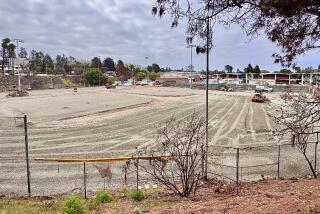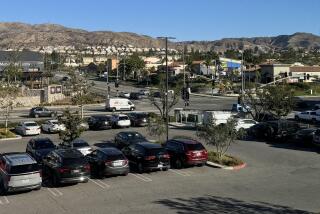Neighbors Fight Plan for Public Use of School Gym
- Share via
Amid tree-lined streets in a Los Angeles Mid-City neighborhood lies a community united over a school’s need for a new gymnasium, yet bitterly divided over plans to open the sports facility to the public during after-school hours and on weekends.
The controversy pits area homeowners against a well-known magnet middle and high school they have traditionally supported. Residents worry that public use of the gym and athletic fields will bring increased noise, traffic and security issues, and feel that their voices should have been heard when the school was defining the scope of the project.
About 200 residents in the immediate vicinity of the Los Angeles Center for Enriched Studies, or LACES, as it is commonly known, say the school’s principal did not seek their input when deciding to build the $9.5-million facility.
They have formed a coalition asking for construction plans to be halted until they can assess the facility’s impact on the community.
In contending that its opinion did not count, the neighborhood coalition is not alone. Several City Council members--among them Mike Hernandez, Nick Pacheco and Cindy Miscikowski--have complained to the district about engaging in construction projects without better communication with area residents.
The campus is on 18th Street north of Venice Boulevard between Fairfax Avenue and La Cienega Boulevard.
“The school district operates in a vacuum; in their decision-making process they don’t involve the community,” said Hernandez, who in a recent council meeting raised the issue to Howard Miller, the Los Angeles Unified School District’s chief operating officer. Other council members told Miller they often hear from school project officials only after a problem with neighbors has developed.
Board of Education member David Tokofsky said the situation “speaks to the problem that schools have become islands in the middle of the community.”
“There is a real lack of the old model of schools being connected to the neighborhood,” he said.
However, Principal Marion Collins said that to the best of her knowledge, all neighbors were well aware of the proposed project. “I was a little bit shocked that people [are upset]. I work and live here, why would I want problems?” she asked.
Taking center stage in the disagreement over the project is the extent of community support as presented by Collins to the school district and city officials. Her portrayal of broad-based support for the complex was crucial when the district decided to exempt the school from doing a traffic, noise and parking impact assessment, said Michael DeLuca, deputy director of real estate and asset management at the district. His office granted the exemption in 1998.
The district would have never exempted the school had there been any hint of controversy among residents, DeLuca said. Granting the exemption also had the effect of relieving the school from sending out official notices to homes within a 300-feet radius of the property, he said.
The notion of full community support played a key role in obtaining funds, DeLuca said. The school got $866,000 from city Proposition K funds (approved by voters for enhancement of park facilities), and $7.5 million from the district.
The residents say Collins misrepresented the scope of community approval when seeking funding for the project. Two residents have signed affidavits stating that their signatures were forged in a letter of support from a neighborhood association that was included in the Proposition K application.
Collins said the purpose of the letter was “certainly not to deceive.” She insisted that the association, Neighbors United, had expressed support for the complex and signed a letter to that effect in 1996. She said she could not find the letter when she prepared the 1997 application, so it had to be retyped. By then the group’s officers had changed, but Collins said she did not seek the new officers’ signatures because she had the group’s approval.
A look into the proposal also reveals that the majority of support letters from parents or area residents came from people who lived several blocks away from the school. Most homeowners with properties next to the school had no idea the project was happening until January, although planning has been underway for more than three years, said resident Sam Ingraffia.
“I went from house to house, down [my street], and nobody seemed to know,” he said.
Collins said she recalls several community meetings at LACES at which hundreds were told of plans to build the sports complex.
Thelma Hilliard, who lives several blocks away from the school, said she attended those meetings. “There really is no reason why somebody should not know [about the project] if they cared about their community,” she said. “You have to stay on top of what’s going on in the community.”
Councilman Nate Holden, who also was present at the sessions, said the project was discussed there.
What remains unclear is whether authorities did sufficient outreach to ensure that all neighbors--especially the ones living next to the school--knew about those gatherings or the project.
Fliers announcing town hall and City Council district meetings, which were distributed by LACES students throughout the neighborhood, did not explicitly state that the sports complex would be discussed, Hilliard said. She added that residents from across Holden’s 10th council district attended the meetings, and it was hard to gauge how many lived near LACES.
The city could have sent out official notices to neighbors--due to its involvement in the after-hours use of the facility--but did not do so because the district was considered to be the lead agency in the project, said Sylvia Lacy, field office deputy for Councilman Nate Holden.
Even as the debate escalates, few would argue that the school facilities are not in need of remodeling. The gymnasium is in precarious condition. Built in 1917, it has not been used by the school’s 1,500 students since the property was acquired from a school previously on the site.
Students can’t take showers or use lockers, for health and safety concerns. The one indoor court is smaller than regulation size and its ceiling is low. Outdoors, the school’s soccer and softball teams practice on pavement.
Plans are for the old gym to be torn down. The larger, new gym would house a pool, a basketball court and a community room. And outdoors, grass fields will replace the sea of asphalt.
Resident Susan Strick, who has raised objections to the project, sympathizes with the coaches and players. “We don’t want this to be a ‘not in our backyard’ argument,” she said. “Let the kids have their gym, but don’t open it to the public.”
But Collins says after-hours use of the school facilities is already taking place. About 500 people attend Saturday classes, and sports activities during the week usually last until 4:30 p.m., she said.
“I guess I didn’t see it as that big a deal,” said Collins, explaining that there will never be as many people at the school during public use of the complex as there are during school hours.
Officials at the city Department of Recreation and Parks say that they still don’t know what the facility’s hours of operation will be, nor the kinds of activities that will be available to the public, because there is still no budget for the project.
Still, Collins says that she has made one thing clear to the city department: No outdoor use of the grounds will be allowed after dark.
In spite of those assurances, residents say that they are wary of additional parking, noise and security issues because they already face some of these problems. Several neighbors said that people jump their fences at night to leave the school grounds.
Because the Mid-City area lacks good recreational facilities, Collins said, she saw the sharing of facilities as beneficial for the community. Such joint-use agreements have been established in about two dozen district schools, DeLuca said.
Collins and school district officials now say that they are willing to meet with the neighbors and hear their concerns.
“I can’t imagine the school district will not address this. Why wouldn’t we?” DeLuca said. “These are quality of life issues. I wish we had understood better at the time what the issues were.”
More to Read
Sign up for Essential California
The most important California stories and recommendations in your inbox every morning.
You may occasionally receive promotional content from the Los Angeles Times.













